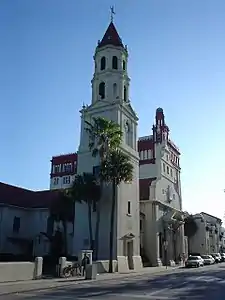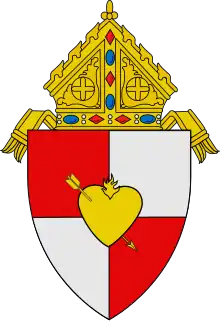Roman Catholic Diocese of St. Augustine
The Roman Catholic Diocese of St. Augustine is a diocese of the Catholic Church's Latin Church in the U.S. state of Florida. Part of the Ecclesiastical Province of Miami, it covers much of North Florida, including the cities of St. Augustine, Jacksonville, and Gainesville. The bishop's seat is the Cathedral Basilica of St. Augustine; the current bishop is Felipe de Jesús Estévez.
Diocese of St. Augustine Dioecesis Sancti Augustini Diócesis de San Agustín | |
|---|---|
 Cathedral-Basilica of St. Augustine | |
 | |
| Location | |
| Country | |
| Territory | |
| Ecclesiastical province | Province of Miami |
| Population - Catholics (including non-members) | 171,000 (8.3%) |
| Information | |
| Denomination | Catholic |
| Sui iuris church | Latin Church |
| Rite | Roman Rite |
| Established | March 11, 1870 |
| Cathedral | Cathedral-Basilica of St. Augustine |
| Patron saint | St. Augustine |
| Current leadership | |
| Pope | Francis |
| Bishop | Felipe de Jesús Estévez |
| Metropolitan Archbishop | Thomas Wenski |
| Bishops emeritus | Victor Galeone |
| Map | |
 | |
| Website | |
| dosafl.com | |
St. Augustine is the oldest continuously inhabited European-established settlement in the continental United States. The city was part of other dioceses until March 11, 1870, when the Diocese of St. Augustine was created. It covered most of the Florida peninsula until the 1950s, when Florida's expanding population necessitated the creation of new dioceses.
History
Having secured Spanish supremacy by defeating the French and planting a permanent colony at St. Augustine in 1565, Pedro Menéndez de Avilés tried to evangelize the Indians. He had been accompanied by four priests. Nombre de Dios (mission) is at the spot of the first Thanksgiving Mass celebrated on the grounds.
Martin Francisco Lopez de Mendoza Grajales became first parish priest of St. Augustine, the first established parish in the United States. Pending the arrival of regular missionaries, Menéndez appointed soldiers he deemed qualified to give religious instructions to the Indians.
The Jesuits were the first to arrive. Three were sent by St. Francis Borgia in 1566 and ten in 1568. The few who survived the martyrdom of their brethren were recalled in 1572.
In 1577, the Franciscans arrived. In 1597, a young chief, smarting from a reprimand, instigated a general massacre of the missionaries.
In 1609, several Indian chiefs sought baptism at St. Augustine. Evangelizing became easier afterwards. This lasted past the middle of the century. In 1634, the Franciscan province of St. Helena, with mother-house at St. Augustine, contained 44 Indian missions, 35 missionaries, and 30,000 Roman Catholic Indians. By 1674, evidences of decline begin to appear. Bishop Calderon found his episcopal jurisdiction questioned by the friars. Although he confirmed many Indians, he complained of their religious ignorance.
Relations between the colonists and natives worsened. The colony was menaced by the growing English power to the north. In 1704, the blow fell. Moore's raid burned, plundered, destroyed, and enslaved the natives at the Mission San Luis de Apalachee.
Efforts at re-establishment partially succeeded. By 1720, there were six towns of Roman Catholic Indians and several missions. Persistent conflict between the Spanish and English colonies reduced these to four missions with 136 people by 1763. The cession to England in 1763 resulted, not merely in the final extinction of the missions, but in the complete obliteration of Florida's ancient Roman Catholicity.

Formation of Dioceses
St. Augustine began its existence as a regularly constituted parish of the Diocese of Santiago de Cuba. Its church records, dating from 1594, are preserved in the archives of the present cathedral. The first recorded episcopal visitation was made by Bishop Cabeza de Altamirano in 1606. In 1674, Bishop Gabriel Diaz Vara Calderon visited the Floridian portion of his diocese; he conferred minor orders on seven candidates, and during an itinerary of eight months, extending to the Carolinian confines, confirmed 13,152 persons, founded many mission churches, and liberally supplied others. The permanent residence of Bishops-Auxiliary Resino (1709–10), Tejada (1735–45), and Ponce y Carasco (1751–55) at St. Augustine, demonstrates that, despite the waning condition of the colony and missions at this period, the Church in Florida continued episcopal oversight. Bishop Morell of Santiago, exiled from his see during the English occupation of Havana (1662–63), remained four months at St. Augustine, confirming 639 persons. When Florida in 1763 passed under English rule, freedom of worship was guaranteed, but the illiberal interpretation of officials resulted in the general exodus of Roman Catholics, so that by 1765, the bi-centenary year of the Church in Florida, a few defaced church buildings presented the only evidence of its former Catholicity. Five hundred survivors of the New Smyrna colony of 1,400 Roman Catholics, natives of Mediterranean lands, settled at St. Augustine in 1776 and preserved the Faith alive through a trying epoch. In 1787, Florida became subject to the newly constituted See of St. Christopher of Havana, and the following year Bishop Cyril de Barcelona found the church at St. Augustine progressing satisfactorily under the care of Fathers Hassett and O'Reilly, who had arrived on the retrocession of Florida to Spain in 1783.
In 1793, Pius VI established the Diocese of Louisiana and the Floridas, appointing the Right Rev. Luis Peñalver y Cardenas, with residence at New Orleans, as first bishop. After Bishop Peñalver's promotion to the Archbishopric of Guatemala in 1801, no successor having been appointed, Louisiana, which was annexed to the United States in 1803, came under the jurisdiction of Bishop Carroll of Baltimore in 1806, the bishops of Havana reassuming authority over Florida until the appointment of the Rev. Michael Portier in 1825 to the new Vicariate of Alabama and Florida. Bishop Portier undertook single-handed the work of his vast vicariate, not having a single priest, until at his request, Bishop England of Charleston sent Father Edward Mayne to St. Augustine in 1828. In 1850, the See of Savannah was created and included that part of Florida which lies east of the Apalachicola River; this was constituted a separate vicariate in 1857 under the Right Rev. Augustin Verot as vicar apostolic and erected into the Diocese of St. Augustine in 1870, with Bishop Verot, who had occupied the See of Savannah since 1861, as first bishop. Bishop Verot's unwearied activity and zeal in promoting religion and education soon bore fruit; schools were opened by the Christian Brothers and the Sisters of Mercy in 1858, but the outbreak of the Civil War frustrated all hopes of success. In 1866, the Sisters of St. Joseph were introduced from France, and despite the most adverse conditions, they had several flourishing schools and academies in operation before many years. The era of progress inaugurated by Bishop Verot continued under the administration of Bishop John Moore (1877–1901), whose successor, the Right Rev. William John Kenny, was consecrated by Cardinal Gibbons 18 May 1902, in the historic cathedral of St. Augustine. The Catholic population of the State, including 1750 coloured Catholics, is (1908) about 30,000. The Diocese of St. Augustine, wholly included within the State, contains about 25,000 Catholics; there are 49 priests with 40 churches and several missions, and 2897 young people under the care of religious teaching institutes. That portion of the state situated west of the Apalachicola River forms part of the Diocese of Mobile since 1829; the Catholic population is about 5000, there are five churches with resident priests and 6 Catholic schools with 807 pupils; Pensacola, founded 1696, is the Catholic centre.
![]() This article incorporates text from a publication now in the public domain: Herbermann, Charles, ed. (1913). Catholic Encyclopedia. New York: Robert Appleton Company. Missing or empty
This article incorporates text from a publication now in the public domain: Herbermann, Charles, ed. (1913). Catholic Encyclopedia. New York: Robert Appleton Company. Missing or empty |title= (help)
Reports of sex abuse
In March 2020, the Diocese of St. Augustine removed former Gainesville Father John H. Dux from ministry after determining that sex abuse allegations against him from 1976, which were now well beyond the state of Florida statute of limitation for a criminal case, were credible.[1] In November 2020, the state of Florida released a list of 97 Catholic priests who were "credibly accused" of committing sex abuse, with five accused of committing sex abuse while serving in the Diocese of St. Augustine.[2] However, a total of 13 priests on this statewide list were tied to the Diocese of St. Augustine.[3]
Bishops
Bishops of Saint Augustine
The list of ordinaries of the diocese and their years of service:
- Augustin Verot, P.S.S. (1870–1876)
- John Moore (1877–1901)
- William John Kenny (1902–1913)
- Michael Joseph Curley (1914–1921), appointed Archbishop of Baltimore-Washington
- Patrick Joseph Barry (1922–1940)
- Joseph Patrick Hurley (1940–1967), Archbishop (personal title) in 1949
- Paul Francis Tanner (1968–1979)
- John J. Snyder (1979–2000)
- Victor Galeone (2001–2011)
- Felipe de Jesús Estévez (2011–present)
Auxiliary Bishop
- Thomas Joseph McDonough (1947-1957), appointed Auxiliary Bishop of Savannah and later Bishop of Savannah and Archbishop of Louisville
Other priests of this diocese who became bishops
- Maurice Patrick Foley, appointed Bishop of Tuguegarao in the Philippines in 1910
- William Turner, appointed Bishop of Buffalo in 1919
- John Joseph Fitzpatrick (priest here, 1948-1958), appointed Auxiliary Bishop of Miami in 1968 and later Bishop of Brownsville
- William Thomas Larkin, appointed Bishop of Saint Petersburg in 1979
- Joseph Keith Symons, appointed Auxiliary Bishop of Saint Petersburg in 1981
- Robert Joseph Baker, appointed Bishop of Charleston in 1999 and later Bishop of Birmingham
- Thanh Thai Nguyen, appointed Auxiliary Bishop of Orange in 2017
High schools
- Bishop John J. Snyder High School, Jacksonville
- Bishop Kenny High School, Jacksonville
- St. Francis High School, Gainesville
- St. Joseph Academy, St. Augustine
Elementary schools

- St. Michael Academy (PreK-8), Fernandina Beach
- Annunciation (PreK-8), Middleburg
- Blessed Trinity (PreK-8), Jacksonville
- Cathedral Parish (K-8), St. Augustine
- Christ the King (PreK-8), Jacksonville
- Epiphany (K-8), Lake City
- Holy Family (PreK-8), Jacksonville
- Holy Spirit (PreK-8), Jacksonville
- Morning Star (Ungraded), Jacksonville
- Palmer Academy (PreK-8), Ponte Vedra Beach
- Queen of Peace (PreK-8), Gainesville
- St Elizabeth Ann Seton (PreK-8), Palm Coast
- San Jose Catholic (PreK-8), Jacksonville,
- Sacred Heart (PreK-8)
- St. Paul's, Jacksonville Beach
- St. Paul's Riverside (3 years old - 8th grade), Jacksonville
- St. Matthew's (Prek- 8), Jacksonville
- Holy Rosary, Jacksonville,
- St. Pius, Jacksonville
- Resurrection, Jacksonville
- St. Patrick's (PreK-8), Gainesville
Parishes
There are 52 active parishes in the Diocese of St. Augustine.[4]
Basilicas
- Basilica of the Immaculate Conception - Pope Francis raised Immaculate Conception in Jacksonville to a Minor Basilica in 2013.[5]
- Cathedral Basilica of St. Augustine (St. Augustine, Florida) - Originally established in 1565 and re-built in the 18th century, it is the oldest church in Florida.
Coat of Arms
 |
|
See also
References
- https://www.wcjb.com/content/news/Former-Gainesville-priest-accused-of-sexual-abuse--569029131.html
- https://www.news4jax.com/news/local/2020/11/09/5-priests-who-worked-in-diocese-of-st-augustine-were-credibly-accused-of-sexually-abusing-children/
- https://www.news4jax.com/news/local/2020/11/10/who-are-the-13-diocese-of-st-augustine-priests-with-credible-allegations-of-sex-abuse/
- "Diocese of St. Augustine".
- "Jacksonville's Immaculate Conception named a Minor Basilica". Florida Times Union. Retrieved 2016-12-12.